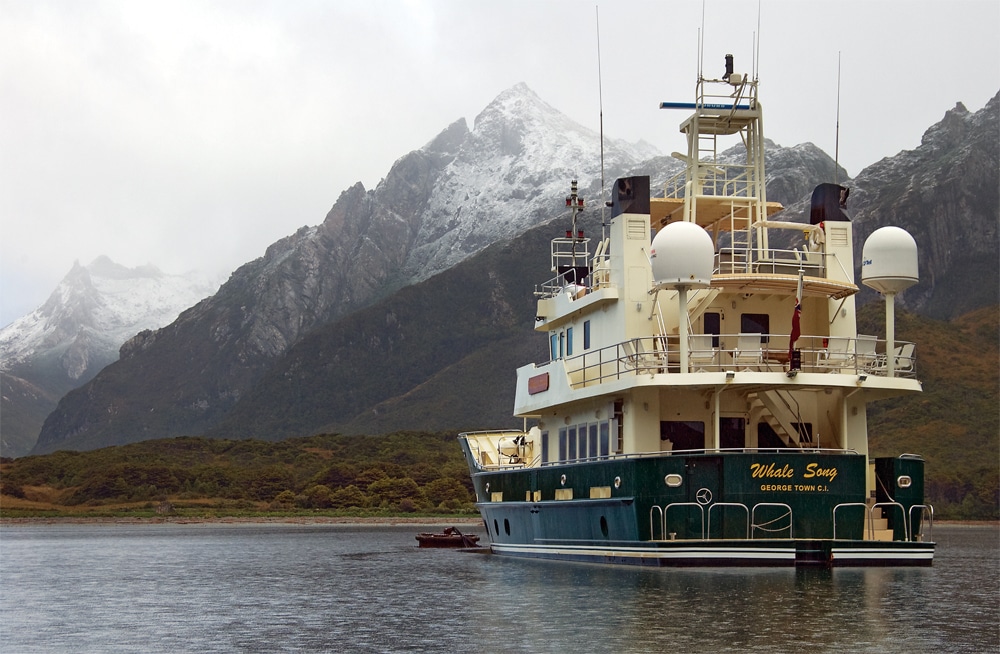
Around the World Aboard Whale Song
The first wandering albatross banked through pearly fog soon after Whale Song crossed 60 degrees south and the sea plunged to 35 degrees Fahrenheit. Drake Passage breathed long swells, never truly waking up until we had swung around Peninsula Fildes, King George Island, to stop and rest. Not for long. The two chinstrap penguins, precariously perched on a drifting islet of sloping ice, woke up and focused on the chain racket Whale Song made, as we weighed anchor in a hurry. The wind veered rapidly and the gravel beach astern looked too close. The ice began arriving — chunks the size of Volkswagen beetles led the way, aiming into our anchorage in Caleta Ardley. We had to move even though we had arrived only hours earlier after the passage from Cape Horn. No one on board minded: We had made it to Antarctica!
Less than a year earlier my wife Nancy and I had signed on as mate and captain (respectively) to prepare the 94-foot Trinity Halter expedition yacht for the worst the oceans can stir up. Planning a five-year circumnavigation, Grant Wilson bought the powerful steel yacht, rated ice class and A1 by the American Bureau of Shipping, in Florida in January 2006. The voyage we planned would take us to the Falklands, Antarctica, Chile, Peru, the Galápagos, the Pacific Northwest, Alaska, Japan, the Southwest Pacific, Australia, Papua New Guinea, southeast Asia, the Indian Ocean, South Africa, West Africa and the Mediterranean. You got it — the long way around! A man of action and an inveterate adventurer, Wilson wasted no time. Within a week of her purchase Whale Song was in the Bahamas using the rough winter weather to find out what upgrades she needed. After a sojourn there, Whale Song moved to Thunderbolt Marine in Savannah, Georgia, to get the needed refit. Last-minute work on the keel coolers was done at Fairhaven Shipyard in Massachusetts. (See “Planning for Peril,” to read about Whale Song‘s equipment and systems upgrades.)
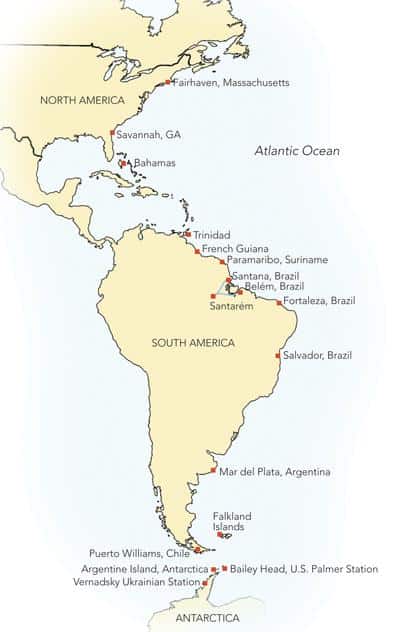
On July 27 we hit the sea, turned south and finally breathed fresh ocean air. Two nights later, in the Gulf Stream, Whale Song crashed through seas that were out of proportion for 15 knots of southwesterly wind. Dawn revealed that the ocean had swept a large deck bin from the bow. Only the through-bolts remained. August began with Tropical Storm Chris moving west. We anchored for a few hours by San Salvador Island in the Bahamas to prepare for battle: changed all fuel filters, tightened the storm covers for the opening ports in the hull, closed the air-conditioner intakes exposed to spray, closed vents for the forecastle and double-lashed all movable gear on deck. Two weeks later we sheltered from another tropical system in Les Saintes near Guadeloupe. Fifty-knot gusts tested our anchors while I hand-pumped hydraulic fluid from the crane tank so I could remove absorbent pads left by the absent-minded yard workers.
We left the bad times behind in Laguna Grande del Obispo in Venezuela — schools of dolphins led the way to an anchorage in a bowl of blue water reflecting the fire red hills. In Trinidad, road trips to lush tropical forests provided a break from building spray-proof covers for the intake louvers on the engine room blowers. In boisterous seas salt spray had squeezed in and coated the engines and generators. Using his Massachusetts Institute of Technology engineering past, Wilson bent an aluminum sheet into clever boxes that didn’t require welding.
Unexpectedly favoring us, the currents in the Serpent’s Mouth between Trinidad and Venezuela accelerated Whale Song toward Georgetown, Guyana. While anchored in the Demerara River, we hired watchmen to guard against night thieves. The next day, downtown merchants feverishly boarded shop windows against riots they expected to follow election results that evening. Off we ran to Paramaribo in Suriname — a multiracial oasis of modernity, prosperity and tolerance: Hindu temples stood side by side with mosques and churches. Then French Guiana’s Iles du Salut, where Papillon‘s Devil Island featured smiling gendarmes, the Jail Museum, a quaint resort and a splendid French restaurant with views of an islet sprouting palms over a sparkling sea. Fearless agoutis grazed openly while bright-eyed, mustachioed monkeys pranced overhead.
In Santana, 150 miles from the 22-mile-wide bar across the Amazon River entrance, our Brazilian ship agent brought on board 11 clearing officials and promised the customs gang later. Remembering Sir Peter Blake’s tragic murder here, Whale Song‘s owner hired two armed bodyguards, soldiers on leave. We loved these two Arnold Schwarzenegger look-alikes who helped with dock lines and cooking and provided us with a restful night’s sleep. Our river pilot, Judas Tadeu Barbosa Lima, steered up and down the river – charts cannot keep up with the changing shoals, and that September the water was falling at two feet per week.
Water buffalo grazed on vast lowlands of the river, whose waters carried timber barges and ferry boats filled to the gunwales with people. Although we passed schools of pink boto dolphins and multitudes of birds winged overhead, humans were the main species to watch. On the night of the Sao Francisco fiesta in the town of Monte Alegre, Piauí, 5,000 candles floated by Whale Song. On most tributaries small shipyards on slanting mud banks produced wooden vessels. Huts on stilts fronted the crumbling Fordlandia, Henry Ford’s failed attempt to grow rubber trees on Rio Tapajos. Only in the side creeks did we find birds – green and red parrots, toucans, raptors and kingfishers large and small. The tree branches were heavy with six-foot-long oropendola nests.
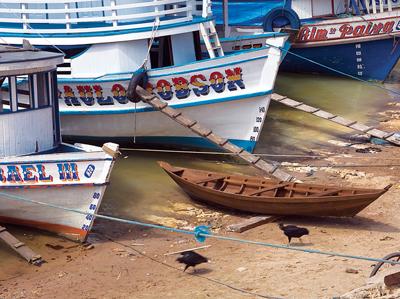
On the way downriver, in the boardwalk town of São Sebastião da Boa Vista, we pushed through market day traffic. The meat stalls sold butchered cows – heads, hoofs and entrails included. In the next row, hand presses squeezed palm fruit into the celebrated açai juice. The old Portuguese city of Belém would have been worth a trip by itself. With the sun just waking up, fishing boats jostled into the Ver-o-Peso market basin. From the estuary waters came the fish of the region: sarda, dourado, filhote, the patterned tucunaré and the giant catfish pirarucu. Across the basin, boats unloaded black-tusked boars that fought ferociously. Other boats groaned under mountains of green coconuts, bulging bags of charcoal and stacks of yucca leaves. Up a street the medicinal stalls sold snakeskins and boto dolphins’ jaws and eyes.
Outside in the Atlantic, the October southeasterly trades blew hard. Plunging into some impressive seas changed our focus back to the Southern Ocean. At each new port we added to our defenses. In Fortaleza in Brazil, the heavy spare propellers migrated from the bow to the boat deck and onto a base made by the welders at the Inace Shipyard. A shipment of Lexan storm covers for the salon windows caught up with us in Salvador, Bahia, a city of baroque churches dripping gold and the blood of suffering saints and slaves, the vast cruising ground of bays and rivers, and saveiros under gigantic lateen sails.
After Cabo Frio the sea cooled to 70 degrees Fahrenheit, the ocean swells lengthened and the fin of the port stabilizer got stuck. We pinned it in neutral and Whale Song continued with the starboard fin happily dampening the roll. A day later, at anchor at Ilha de São Sebastião, we found the problem – a loose setscrew on a potentiometer. The last week of November, in the Argentine port of Mar del Plata, we chased down carpenters to make heavy plywood emergency shutters – just in case the pilothouse windows got punched in south of Cape Horn. We felt the ship was as ready as possible.
Every mile southward sea life became more plentiful. With the Falkland Islands just thickening the horizon, the wind began whistling from the north. Birds soared: mollymawks (albatrosses), big petrels, the pintados – Antarctic petrels, Cape petrels, tiny Wilson’s petrels, royal albatrosses, imperial shags, terns. In the clear sea, black and white Commerson’s dolphins raced the bow and gentoo penguins porpoised at high speed. The winds howled through the islands, and we were lucky to anchor in Port Stanley over three days of good weather, a rarity on this incongruous mote of Britishness in the Southern Ocean. There we saw elephant seals and sea lions at the shore while cows and sheep grazed on the meadows above. Genetically isolated wildlife has made the Falklands a Galápagos of the Southern Ocean. On New Island, the kingdom of Ian Strange and the home of artists Kim and Tony Chaters, we sat among breeding rockhopper penguins and black-browed albatrosses (bigger than overfed geese). I turned around at a deliberate flap, flap sound behind – an albatross marching by only inches away. A predatory skua snatched an egg in its beak. Another swooped down, and the two fought, the forgotten egg crushed and seeping yolk.
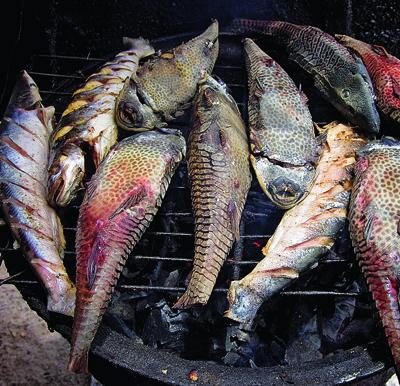
Every yacht’s voyage to Antarctica begins with a clearance in Puerto Williams, the Chilean naval post on the Beagle Channel and the home of Micalvi Yacht Club – the southernmost pub in the world. We didn’t get far from there – the weather kicked up, forcing a stop in Caleta Lientur. The williwaws began their blitzkrieg around midnight, and Whale Song dragged slowly. The windlass seemed overloaded, which made sense when the anchor that broke the surface was not ours but an Admiralty kind – about four times the size of ours, which had hooked this one and was now dangling below like a key chain ornament!
Crossing Drake Passage delivered us to a different space. Deception Island, South Shetland, looked out of this world. With Whale Song anchored by the Sewing Machine Needles off the east coast, we explored the empire of a billion penguins on Bailey Head. In Whaler’s Bay the rusting heaps of a Norwegian whale slaughterhouse looked haunted in the soft snowfall. In Pendulum Cove Whale Song‘s braver souls splashed in a shore pool as comfortably as baleen whales – a subterranean volcanic hell keeps the water hot. Above the swimmers rose hillsides of ash-black snow and ice, a reminder of the violent 1967 eruption.
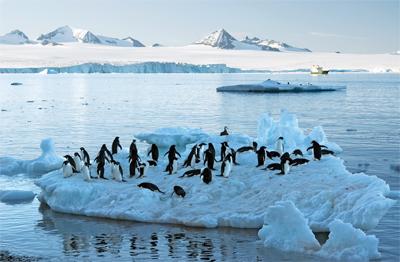
In Gerlache Strait, the blindingly white peaks, slashed in places by coal-black razor ridges, rose in a crescendo of grandeur over the blue cliffs of ice at the water’s edge. Here the fattest of cruise ships looked like toy boats of bad design. People of the scientific sort live here, on the rims of Antarctica, in several stations. Whale Song tied bow and stern across a creek at the U.S. Palmer Station, and the hosts gave us lunch and a tour of the research projects. In the Argentine Islands, with our little ship dangling on a web of mooring and anchor lines in Skua Creek, Wilson took the tender to the Vernadsky Ukrainian station, only to be force-fed, at 0900, glasses of vodka distilled in-house. I didn’t go, which was a good thing – an iceberg drifted in and toppled over at the Creek’s entrance, leaving little space for us to squeeze through.
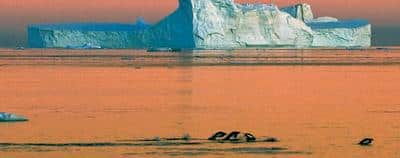
There, at 65 degrees 15 minutes south, intimidated by growing numbers of icebergs and the shortage of anchorages farther south, we pointed Whale Song northward. We would try to enter Erebus and Terror Gulf in the Weddell Sea via Antarctic Sound – a voyage into a very different sea and icescapes. Look for Part Two of this four-part series on Whale Song‘s adventure in the June issue of YACHTING.
Read Part Two: From Antarctica to the Philippines
Planning For Peril
Whale Song‘s upgrades left nothing to chance.
In the Bahamas, we worked on noting where Whale Song‘s equipment and systems could be improved for her circumnavigation. We couldn’t reduce the 8.5-foot draft, which would have been handy in this shallow archipelago and in others we would visit on our travels. However, the two caterpillar 3406 mains and caterpillar 3340s spinning two Kilo-Pak 65 kW generators were cooled via keel coolers so the sand that the props stirred didn’t affect them. But we noticed that powering over steep seas in rough passages between the islands caused the sea chest supplying water to cool the Naiad stabilizers and the air conditioners to gulp air. This shut the systems down, so we had to change the intake and install self-priming pumps. The list grew beyond that — fast. The booster pumps for the 1,000-gallon-per-day Sea recovery watermakers, being mounted too high, also sucked air. They had to be lowered below the waterline. The watermaker filtering system, adequate for the plankton-poor Caribbean, needed an upgrade with gravel filters for the rich, cold seas ahead of us.
The derrick-style boom made launching the tender difficult if the boat rolled even slightly. Exposed to the salt air, its electric motors wouldn’t last — we needed a hydraulic crane. In the coming years Whale Song would anchor most of the time, and we saw that the windlass wasn’t centered over the chain lockers — one of the crew would have to flake the heavy three-quarter-inch chain as it was coming in. moving the windlass, a heavy beast designed for small ships, wasn’t an option. At the very least, we needed an additional platform in the chain locker for the “chain flaker.”
I noticed a lot of water in the chain locker. The chains dripped and, in heavy head seas, water ran down the hawse pipes under the windlass. The space had no pipe to the main bilge pump system. The pipes from bilges in three other compartments created by watertight bulkheads ran to the manifold in the engine room, but the chain locker needed its own independent pump. Drilling for its outlet through five-eighths inch of steel proved what a stout ship we had.
By the end of March, a Syncrolift had deposited all of Whale Song‘s 280 tons on the hard at thunderbolt marine in Savannah, Georgia. The yacht started shedding equipment — rudders, propellers and shafts, stabilizer fins, bow-thruster propeller, life rafts, skin fittings, fire extinguishers, etc. — creating a mound under the stern, all ready to be inspected, updated, repaired or replaced. The interior was changing too. The salon furniture went out and the new layout designed by owner grant Wilson took shape. All staircase passages received stainless handholds to keep people on their feet in rough weather.
A new computer processor with two large monitors replaced small digital plotters. With the two Furuno 75-mile radars, the pilothouse looked fit for the oceans. The filtering units for the engines and generators were boosted to a larger size — helpful with dirty fuel sold in remote places. Men crawled into all of the tanks looking for corrosion.
On June 1, Wilson chased off the electrician testing the crane and the ABS Nautical Systems inspector, who had been putting me in tight spaces to demonstrate that every alarm worked. Whale Song dropped down the Wilmington river and powered north on gentle Atlantic swells. We soon discovered that the keel coolers were leaking. The yard workers had made gaskets instead of ordering them from the manufacturer. Whale Song would have to haul out again fairly soon. After farewell parties and a Fourth of July celebration on Cape Cod, Massachusetts, Whale Song moved to Fairhaven Shipyard, where mechanics carefully removed four keel coolers (of an efficient but fragile design) and popped in the new seals. The compartments housing the stabilizer actuators had waterproof, bolt-on covers. Made of heavy steel, they were impossible to handle in the bowels of the ship at sea. Fairhaven Shipyard welders replicated them with aluminum. To our deck equipment we added a smaller tender with an aluminum bottom for rocky landings, drums of stern warps for Antarctica and the Chilean channels and a stern anchor. We were as ready as we’d ever be!









